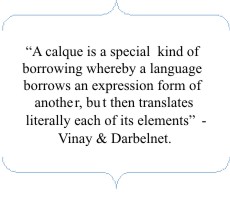Direct and Oblique translation
Jean Paul Vinay and Jean Darbelnet in the 1950s, wrote a seminal work that became very important for the practitioners of translation. They came up with seven methods of translation and as many ways to attain equivalence. They observed: “Equivalence of messages ultimately relies upon an identity of situations, and it is this alone that allows us to state that the TL may retain certain characteristics of reality that are unknown to the SL” (Venuti 87). Their view was that if literal translation or direct translation was impossible, then the translator would have to resort to what they termed oblique translation. Oblique translation is another term for free translation where the translator exercises his/her freedom to attain equivalence; this might perhaps result in what Catford terms ‘shifts'.
Direct or literal translation “is the direct transfer of a SL text into a grammatically and idiomatically appropriate TL text in which the translator's task is limited to observing the adherence to the linguistic servitudes of the TL” (Venuti 86). This naturally means that the translator has to operate within certain limits and is not free to appropriate the language to suit his/her ends. When does a direct translation fail? According to Vinay and Darbelnet it fails when the TL translation fails to convey anything meaningful for various reasons. It might not have the exact structural equivalent or might not have a corresponding expression. Idioms are the best examples of this. “It is raining cats and dogs” in English cannot be translated literally into Hindi or most Indian languages, for that matter.
In cases like these the translator will have to resort to oblique translation. Here the translator has to fall back on “identity of situations” or aim for an approximately accurate replication of the impact of the SL text. Vinay and Darbelnet are of the view that the translator has to keep in mind the totality of the message that is to be communicated and exercise her/his judgement in the method of translation A translator might someti mes choose to borrow a certain expression or saying from one language . This results in what is termed in linguistics as calque, or a literal, word-for-word translation. However, Vinay and Darbelnet caution: “But the responsibility of introducing such calques into a perfectly organised language should not fall upon the shoulders of translators: only writers can take such liberties, and they alone should take credit or blame for success or failure” (“A Methodology for Translation”, 90).. Ultimately, they point out, it is the message alone that can help us to judge if the translation has attained equivalence. mes choose to borrow a certain expression or saying from one language . This results in what is termed in linguistics as calque, or a literal, word-for-word translation. However, Vinay and Darbelnet caution: “But the responsibility of introducing such calques into a perfectly organised language should not fall upon the shoulders of translators: only writers can take such liberties, and they alone should take credit or blame for success or failure” (“A Methodology for Translation”, 90).. Ultimately, they point out, it is the message alone that can help us to judge if the translation has attained equivalence. |